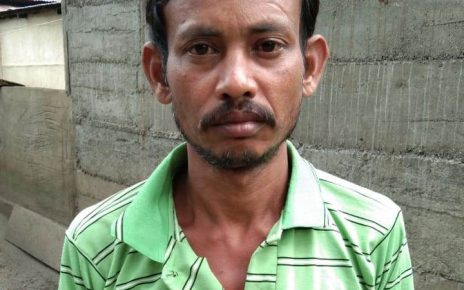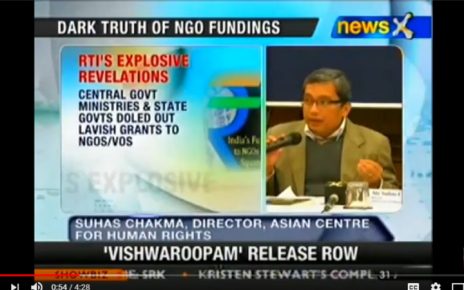- As the new year approaches, the country continues to witness large-scale protests against the Citizenship Amendment Act and the National Register of Citizens.
- Suhas Chakma, Director of the Rights and Risks Analysis Group, spoke on these issues in detail in an interview with Firstpost.
- He fears that the Indian government has planted the seeds of ethno-nationalism in the North East through the CAA
As the new year approaches, the country continues to witness large-scale protests against the Citizenship Amendment Act and the National Register of Citizens. Critics have termed the legislation as one that contravenes the secular values of the Constitution, while the Central government says that it does not apply to Indian citizens, and is only aimed at giving shelter to persecuted minorities in neighbouring countries.
Suhas Chakma, Director of the Rights and Risks Analysis Group, spoke on these issues in detail in an interview with Firstpost. Chakma, who is also an advisor to the All India Chakma Social Forum, has worked with Chakma and Hajong migrants, as also with Tibetan, Tamil, Chin and other refugees recognized by the UN High Commissioner for Refugees in India (UNHCR).
Edited excerpts from the interview:
Since the Citizenship Amendment Act is now in force in India, what would be the fate of the people living in detention camps in Assam?
At present, there are about 900 people living in detention camps in Assam. Many of them have been living in those camps from before 31 December, 2014. Though we have not counted them as per their religious beliefs, most of the people living in the detention camps are Muslims. The Citizenship Amendment Act (CAA) does not provide any relief to the Muslim detainees. The Hindu detainees are eligible for Indian citizenship under the CAA, but the road to freedom is still quite long for them. As per Section 3 of the CAA which inserted Section 6(b)(3) “any proceeding pending against a person in respect of illegal migration or citizenship shall stand abated on conferment of citizenship to him”. How the detainees will apply for citizenship from the detention camps with no documents to prove “persecution” is a matter of speculation. However, they shall have to remain in detention centres till the conferment of citizenship.
Normally, how long does the process of granting citizenship to victims of religious persecution take?
Though the CAA seems to make granting of citizenship to non-Muslims who have fled persecution in Afghanistan, Bangladesh and Pakistan easier, the reality is that the Ministry of Home Affairs (MHA) does not have an adequate apparatus to grant citizenship to a large number of illegal immigrants. There are only two under secretaries and one director who process applications for citizenship. On 12 February, 2019, MoS Kiren Rijiju informed the Lok Sabha that 605 people were granted citizenship in 2015, 1,106 in 2016 and 816 in 2017. As the government is unable to process the applications, it takes ages to get citizenship. There are about 35,000 Pakistani Hindu refugees who came to India at various points of time since 1965 whose applications have not been processed till date. This is despite the fact that there has been no opposition to the grant of citizenship to these refugees, irrespective of whether the BJP or the Congress was in power. In fact, from 2015 to 2017, more applications were processed as special camps were held. Otherwise, about 100 applications are processed per year.

However, if there is opposition from state governments, it is a completely different scenario. The Chakmas and Hajongs from East Pakistan were settled in Arunachal Pradesh. Pursuant to a Supreme Court judgment dated 9 January 1996, thousands of Chakmas had applied for citizenship in the year 1997-98. The Supreme Court, in a subsequent order on 17 September 2015, directed that citizenship applications should be processed preferably within three months. The MHA sought extension of time and the matter is being monitored by the Supreme Court. But not a single application has been fully processed as on date, since their arrival 55 years ago, and since the judgment of the Supreme Court 24 years ago.
Do you think that the ongoing protests may have any implications in granting citizenship to the refugees?
It will certainly have implications. It is possible that the state governments may not process citizenship applications, and citizenship cannot be granted without local police verification. In Assam, where government officials have been opposing the CAA, if an official does not process the applications or gives adverse remarks, the procedure may become difficult for the applicant.
Even in cases where there is no opposition, refugees in some cases had returned to their country due to the delay in processing the applications. As per an affidavit submitted to the Rajasthan High Court by Foreigners Registration Officer and CID Superintendent of Police Shweta Dhankar, a total of 968 displaced Hindus from Pakistan have returned to the neighbouring country between 2015 and 2017 because of the delay in granting citizenship. And this was during the tenure of the BJP in Rajasthan.
The new law is accused of being partisan and unconstitutional. What is your opinion?
There is no doubt that the law is partisan and unconstitutional. It is partisan because it does not take into account the diversity of religious persecutions, which is wider than the Muslim versus non-Muslim binary. In both Muslim and non-Muslim religious groups, there are different sects. Often, religious discrimination takes place on account of these sects. In a society dominated by Sunni Muslims, a Shia might not be tolerated. Similarly, Ahmadiyyas are declared non-Muslims in Pakistan. On account of this declaration, Ahmadiyyas qualify to be seen as a religious minority. But Ahmadiyyas are not included among the eligible communities for citizenship under the CAA.
If the government is concerned about religious persecution in the neighboring countries, it should also have cared about the Tibetan refugees whose religious persecution is officially recognised by the Government of India. The Indian government is possibly the only government in the world that finances a government-in-exile of the Tibetans, recognising their religious persecution. The fact that the Tibetans have not been included despite them facing religious persecution basically exposes the government’s partisan approach.
It is due to this that the CAA also fails the constitutional validity test. Article 14 guarantees equality before law and equal protection of the law to “every person,” irrespective of whether the person is a citizen or non-citizen. Tibetans persecuted because of their religious beliefs belong to the same class of people as Buddhist Baruas who fled from Bangladesh because of religious beliefs. There cannot be any intelligible reasonable classification between these two categories. There are over a half million people who are recognised as refugees either by the Government of India or the UNHCR with the permission of the Government of India. Neither the court nor the government can ignore their presence within the country.
But according to the central government, granting citizenship to those communities is a historic responsibility of the Government of India.
Historic responsibility is a very loaded term. If the government of India wants to fulfill its historic responsibility, the responsibility will not be complete till about 18 million non-Muslim religious minorities of Bangladesh and six million non-Muslim minorities of Pakistan come to India. It shall not be complete until the descendants of indentured labourers, colonial merchants, artisans etc taken by the British Raj to the Caribbean Islands, South Africa, Réunion, Mauritius, Ceylon, Malaysia, Myanmar, Singapore and across East Africa come home. The atrocities in Afghanistan, Bangladesh and Pakistan have not ended on 31 December, 2014. We cannot say that the historic responsibility ended on that date.
The solution to historic responsibilities does not lie in making India the new Israel of the 21st Century. The solution lies in protecting the people towards whom India has historic responsibilities, whether they are in Fiji or Bangladesh, by working with these governments.
If the Government of India is serious, it must not invite all the tribals of the Chittagong Hill Tracts (CHTs) of Bangladesh to India. Instead, it should use its good offices to implement the Chittagong Hill Tracts Peace Accord of 1997, signed by the Government of Bangladesh and the Jana Samhati Samiti, which represents the indigenous peoples of the region. The fact that the government of India had to exempt states under the Inner Line Permit from the ambit of the CAA indicates that if the religious minorities of the CHTs were to go to Mizoram or Tripura en masse, there would have been new ethnic conflicts.
Are you saying that the amendment would grant no relief to the Hindu, Christian, Sikh, Jain, Buddhist and Parsi immigrants from Afghanistan, Pakistan and Bangladesh?
The only relief the Act grants to them is that they cannot be legally deported back to their country of origin. The detainees in Assam will have to remain in prison till conferment of citizenship as per the Act. If the Foreigners Tribunals start trials of those excluded from the National Register of Citizens in Assam, hundreds of thousands have to stand trial, spend whatever money or resources they have and be sent to detention centres. Ultimately, Section 3 of the CAA abates the proceeding pending against a person in respect of illegal migration or citizenship only on conferment of citizenship.
According to media reports, the Rashtriya Swayamsevak Sangh (RSS) estimates that there are about 1.5 crore alleged Hindus from Bangladesh who will benefit from the CAA. Does the Government of India has the capacity to process these applications? What is the cost of processing the applications if their claims also have to be verified in the country of origin? Will a hostile local administration, like in Assam, process the applications on time?
The CAA is nothing but a political stunt, and will put those who originate from the erstwhile East Pakistan through the grind of the citizenship application process. Those without documents will be first declared as non-citizens, made to fill up application forms and suffer the process of the inquiry and in many cases, a hostile local administration and wait for citizenship. If the case of the Chakmas and Hajongs is an example, most of these people will not get citizenship in their lifetime.
If there is any Hindu Bengali without documents living in the Sixth Schedule Areas or the States under the Inner Line Permit, and if the CAA is implemented in letter and spirit, these Hindus shall have to leave to apply for citizenship. Therefore, all the Hindus without documents living in Meghalaya shall have to be concentrated in parts of Shillong not covered under the CAA.
What change does the new law bring about for Hindus, Christians, Sikhs, Jains, Buddhists and Parsis from Afghanistan, Bangladesh and Pakistan? It is widely feared that India may see an influx of people of these communities in the near future, and that they might apply for citizenship claiming that they came to India before the cut-off date.
The new law sets 31 December, 2014 as the cut-off date of entering into the Indian Territory to be eligible for Indian citizenship. There is no cut-off date for submission of the applications. Except those listed in the NRC in Assam, the government of India has not simply counted the people who have allegedly come. Surely, India cannot only go by the figure of 187 Longer Term Visas granted to Bangladeshi nationals by the MHA from 2011 to 2018.
As there is no cut-off date set for submitting the citizenship applications, if a person applies for citizenship in the year 2024 claiming that he/she entered India before the cut-off date and could not submit the application for some valid reasons and submits an affidavit, he/she shall still remain eligible unless the authorities can prove otherwise.
That is why the exemptions given to the Inner Line Permit (ILP) states in the North East and the Sixth Schedule Areas are nothing but hogwash. Immigration is part of the human evolution. It could not be stopped by the Berlin Wall, it could not be stopped by the US-Mexico border wall, it could not be stopped by the fencing of the Indo-Bangladesh borders, and it will not be stopped by the CAA.
More importantly, if a terrorist who wants to set up a sleeper cell poses as a Hindu and gets citizenship, how will the authorities verify the same? Thousands of Bangladeshis have been claiming refugee status claiming themselves as “Rohingyas” across the world. It is not rocket science.
So are you saying that people in the North East are justified in their fear that the new law may make them minorities in their homelands?
The fear in the North East is based on the post-partition history, and the history is instructive. If the Union of India opens the floodgates for more migration for whatever reason, obviously there will be genuine fears of the tribal communities. They may fear losing their political power and cultural identity, irrespective of whether there is ILP or not.
What this Act does is simple: it takes away the fear of deportation. Any person from these three countries can change official records in his/her country of origin, and claim to be a person who has been persecuted due to religion. Even if the Indian High Commission conducts a verification, the records in the country of origin will show that the person on record is a religious minority.
But India does have to address the issue of persecution of Hindus. What is the way out?
For that, India has to enact a refugee law; and not the CAA. Even after 31 December, 2014, persecuted persons have come and they are actually defined as “illegal immigrants” under the Citizenship Act of 2003. The CAA changed the definition of illegal immigrants only for persons who entered till that date, and not those who have come after that. This indicates that India still needs a refugee law for people like Baldev Kumar, a leader of Imran Khan’s Pakistan Tehreek-e-Insaf party who sought asylum in India in September 2019.
All over the world, claims of persecution are verified, time is given for integration and after a period of time, citizenship is granted, or the person is repatriated if the situation improves in the country of origin. Under the CAA, you have not identified the people, have not assessed claims of persecution, and not even counted the number of people, but straightaway granted citizenship.
The refugee law is very clear – an economic migrant does not qualify for refuge and there is no dispute about it.
What are the other implications of the CAA?
India has actually planted the seeds of ethno-nationalism in the North East through the exemptions given to the Sixth Schedule areas and Inner Line Permit States. If the policymakers think that they can form a parliamentary committee on the North East and remove the ILP at a later stage, then these could be serious mistakes. These states may later witness uncontrollable political violence. India in the coming decades may have to pay a heavy price for planting ethno-nationalism in the North East.




